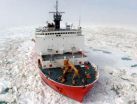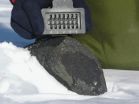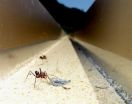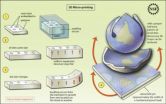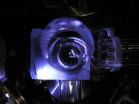LA BioMed investigator, Dr. Rowan Chlebowski, co-authors study on menopausal hormone therapy
Study indicates use of estrogen-only form of menopausal hormone therapy continues to protect women from breast cancer
2012-03-12
(Press-News.org) LOS ANGELES (March 9, 2012) – Rowan T. Chlebowski, M.D., Ph.D., an LA BioMed investigator whose research activities have focused on breast cancer therapy and prevention, and chronic diseases impacting women's health, is co-author of a study that indicates that women who use the estrogen-only form of menopausal hormone therapy appear less likely to develop breast cancer in the longer term, according to new research which was recently published The Lancet Oncology.
A follow-up study of over 7,500 women from the Women's Health Initiative (WHI) trial who took estrogen for about 6 years and then stopped has found that they are over 20 percent less likely to develop breast cancer and remain significantly less likely to die from the disease than those who never used HRT, a period of nearly 5 years after stopping treatment.
"These findings are important in that they provide substantial reassurance regarding the safety of estrogen alone use for women with climacteric symptoms initiated close to menopause for duration similar to those used in this study," said Dr. Chlebowski. "Previously, concern regarding estrogen influence on breast cancer may have inhibited women from considering such therapy."
In 1993, the WHI trial of estrogen alone was established to investigate the effects of conjugated equine estrogen on chronic disease. Nearly 11,000 postmenopausal women ages 50 to 79 who had previously had a hysterectomy** were given estrogen or placebo over a period of nearly 7 years. The trial was stopped in 2004 (a year earlier than planned) because of an increased risk of stroke and blood clots.
In this new study, Dr. Chlebowski and his colleagues report the overall effects of estrogen use on breast cancer incidence and mortality, including extended follow-up of 7,645 women (78 percent of the original surviving members) who were tracked from March 2005 until August 2009, a median (midpoint) 4.7 years after stopping estrogen therapy.
The researchers found a 23 percent reduction in the incidence of invasive breast cancer compared with placebo (151 cases, 0.27% per year vs. 199 cases, 0.35% per year) during an overall follow-up period of nearly 12 years, while women in the estrogen group who did develop breast cancer had a 63 percent reduction in deaths from the disease (six deaths, 0.009% per year vs. 16 deaths, 0.024% per year) compared with those in the placebo group.
The lower risk of breast cancer was restricted to women without a history of benign breast disease or a strong family history of breast cancer. They say: "The continued postintervention effect of estrogen on breast cancer incidence is akin to that reported for other hormone-targeted drugs shown to reduce breast cancer incidence."
However, the researchers also caution: "Our data do not support the use of estrogen for breast cancer risk reduction in light of the lack of benefit noted in populations at higher risk (including those with a strong family history of breast cancer or benign breast disease) and the additional risk of stroke and blood clots."
###
**Women who have not had hysterectomies are not usually prescribed estrogen-only treatment because of a risk of womb cancer.
About LA BioMed
Founded in 1952, LA BioMed is one of the country's leading nonprofit independent biomedical research institutes. It has approximately 100 principal researchers conducting studies into improved treatments and cures for cancer, inherited diseases, infectious diseases, illnesses caused by environmental factors and more. It also educates young scientists and provides community services, including prenatal counseling and childhood nutrition programs. LA BioMed is academically affiliated with the David Geffen School of Medicine at UCLA and located on the campus of Harbor-UCLA Medical Center. For more information, please visit www.LABioMed.org
END
ELSE PRESS RELEASES FROM THIS DATE:
2012-03-12
Researchers in New Zealand have developed a prototype Bluetooth-enabled medical monitoring device that can be connected wirelessly to your smart phone and keep track of various physiological parameters, such as body temperature, heart rate, blood pressure and movements. The prototype could be extended to include sensors for other factors such as blood glucose as well as markers for specific diseases. The connectivity would allow patients to send data directly to their healthcare provider and receive timely advice and medication suggestions.
Writing in the International ...
2012-03-12
Detergents are everywhere – in washing powders, dishwashing liquids, household cleaners, skin creams, shower gels, and shampoos. It is the detergent that loosens dirt and fat, makes hair-washing products foam up and allows creams to be absorbed quickly. Up until now, most detergents are manufactured from crude oil – a fossil fuel of which there is only a limited supply. In their search for alternatives, producers are turning increasingly to detergents made from sustainable resources, albeit that these surfactants are usually chemically produced. The problem is that the ...
2012-03-12
WASHINGTON -- The U.S. Coast Guard Cutter HEALY (WAGB 20) successfully experimented with NRL's TacSat-4 communications satellite, Jan. 24, by communicating from the Bering Sea off the western coast of Alaska to Coast Guard Island, Alameda, Calif.
Returning from an escort and icebreaking mission to Nome, Alaska, assisting the Russian tanker Renda delivery of emergency fuel to the town, USCGC HEALY — Coast Guard's only polar icebreaker — was approximately 260 nautical miles south of the Arctic Circle at the time of the test.
Deployed into a unique, highly elliptical ...
2012-03-12
The first global high-resolution map of the boundary between Earth's crust and mantle – the Moho – has been produced based on data from ESA's GOCE gravity satellite. Understanding the Moho will offer new clues into the dynamics of Earth's interior.
Earth's crust is the outermost solid shell of our planet. Even though it makes up less than 1% of the volume of the planet, the crust is exceptionally important not just because we live on it, but because is the place where all our geological resources like natural gas, oil and minerals come from.
The crust and upper mantle ...
2012-03-12
Creating some of life's building blocks in space may be a bit like making a sandwich – you can make them cold or hot, according to new NASA research. This evidence that there is more than one way to make crucial components of life increases the likelihood that life emerged elsewhere in the Universe, according to the research team, and gives support to the theory that a "kit" of ready-made parts created in space and delivered to Earth by impacts from meteorites and comets assisted the origin of life.
In the study, scientists with the Astrobiology Analytical Laboratory ...
2012-03-12
Washington, DC, March 9, 2012 -- Hospitals whose infection prevention and control programs are led by a director who is board certified in infection prevention and control have significantly lower rates of methicillin-resistant Staphylococcus aureus (MRSA) bloodstream infections (BSI) than those that are not led by a certified professional, according to a new study published in the March issue of the American Journal of Infection Control, the official publication of APIC - the Association for Professionals in Infection Control and Epidemiology.
A team of researchers ...
2012-03-12
Desert ants have adapted to a life in a barren environment which only provides very few landmarks for orientation. Apart from visual cues and odors the ants use the polarized sunlight as a compass and count their steps in order to return safely to their home after searching for food. In experiments with ants of the genus Cataglyphis in their natural habitats in Tunisia and Turkey, behavioral scientists of the Max Planck Institute for Chemical Ecology in Jena, Germany, have now discovered that ants can also use magnetic and vibrational landmarks in order to find their way ...
2012-03-12
Christian Santangelo, Ryan Hayward and colleagues at the University of Massachusetts Amherst recently employed photographic techniques and polymer science to develop a new technique for printing two-dimensional sheets of polymers that can fold into three-dimensional shapes when water is added. The technique may lead to wide ranging practical applications from medicine to robotics
The journal Science publishes the research in its March 9 issue.
Researchers used a photomask and ultraviolet (UV) light to "print" a pattern onto a sheet of polymers, a technique called photolithography. ...
2012-03-12
Researchers have identified a genetic signature for a severe, often painful food allergy – eosinophilic esophagitis – that could lead to improved diagnosis and treatment for children unable to eat a wide variety of foods.
The scientists, from Cincinnati Children's Hospital Medical Center, report in the Journal of Allergy and Clinical Immunology that they have pinpointed a dysregulated microRNA signature for eosinophilic esophagitis (EoE), a disease that also may cause weight loss, vomiting, heartburn and swallowing difficulties.
Interestingly, the dysregulated microRNA ...
2012-03-12
The faster a clock ticks, the more precise it can be. Due to the fact that lightwaves vibrate faster than microwaves, optical clocks can be more precise than the caesium atomic clocks which presently determine time. The Physikalisch-Technische Bundesanstalt (PTB) is even working on several of such optical clocks simultaneously. The model with one single ytterbium ion caught in an ion trap is now experiencing another increase in accuracy. At PTB, scientists have succeeded in exciting a quantum-mechanically strongly "forbidden" transition of this ion and – in particular – ...
LAST 30 PRESS RELEASES:
[Press-News.org] LA BioMed investigator, Dr. Rowan Chlebowski, co-authors study on menopausal hormone therapy
Study indicates use of estrogen-only form of menopausal hormone therapy continues to protect women from breast cancer

